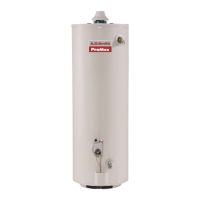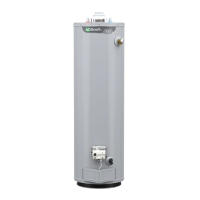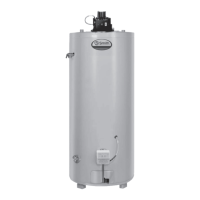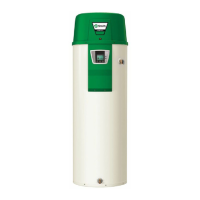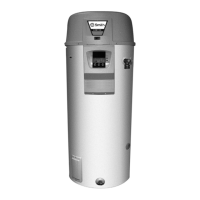39
Draw efficiency is the quantity of hot water available to the consumer before the outlet water temperature
decreases 25 degrees F. A 40 gallon water heater will typically provide 70% (28 gallons) of this “usable” hot
water (60% is the minimum). The burner or elements are allowed to operate during this test. Incoming, cold
water mixes the remaining stored water below this 25 degree limitation.
Energy Factor is an indicator of the combined thermal efficiency and standby efficiency of a water heater. The
higher the energy factor, the more efficient the water heater will be.
Minerals and gases will separate from water as temperature increases.
“R” Value is a measure of the resistance of a substance to heat flow.
Recovery rate is the amount of water that is heated to a set temperature, per hour. An example might be that a
water heater has a recovery rate of 30 gallons of water per hour at 80 degree F. (Fahrenheit) temperature rise.
Standby efficiency – the water heater’s ability to contain heat in the tank. A minimum of tank water heat loss
per hour is desired.
Sample: temperature change = Btu/h loss/ square foot of tank surface
“R” value
Temperature rise is the increase in the temperature from its coldest “inlet” water temperature to the desired hot
(outlet) setting. Typically this is assumed to be 40 degrees entering water, 120 degrees desired stored water or
80 degrees “temperature rise.”
Thermal efficiency is approximately the amount of generated BTU (British Thermal Units), which enters the
water. A percentage of the total BTU passes out through the vent piping.
Water cannot (for all practical purposes) be compressed.
Water expands when it is heated.
Formulas and Conversions:
BTU (British Thermal Unit) is the heat required to raise 1 pound of water 1°F
1 BTU = 252 cal = 0.252 kcal
1 cal = 4.187 Joules
BTU X 1.055 = Kilo Joules
BTU divided by 3,413 = Kilowatts
To convert from Fahrenheit to Centigrade: (° F – 32) times 5/9, or .556, equals degrees C.
One gallon of (120 ° F, 49 ° C) water weighs approximately 8.25 pounds.
Pounds X .45359 = Kilogram
Gallons X 3.7854 = Liters
% of Hot = (Mixed Temp. – Cold) divided by (Hot Temp. – Cold)
% Thermal Efficiency = (GPH X 8.25 X Temp. Rise X 1.0) divided by BTU/H Input
BTU Output = GPH X 8.25 X Temp. Rise X 1.0
GPH = (BTU/H Input X % Eff.) divided by (Temp. Rise X 8.25)
One cubic foot of Natural Gas contains about 1000 BTU of heat.
One “therm” is equal to 100,000 BTU
One cubic foot of Propane Gas contains about 2500 BTU of heat.
One gallon of Propane gas contains about 91,250 BTU of heat.
One pound of Propane gas contains about 21,600 BTU of heat.
GENERAL INFORMATION
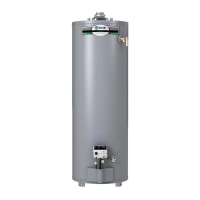
